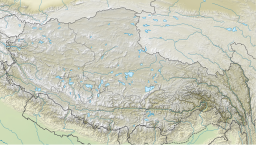Siling Lake (Tibetan: སེར་གླིང་མཚོ, Wylie: ser gling mtsho, ZYPY: Sêling Co; Chinese: 色林错; pinyin: Sèlín cuò), (also known as Qilin or Selincuo) is a salt lake in the Tibet Autonomous Region, China to the north of Xainza. Doijiang is located near the lake. Administratively it belongs to Xainza County and Baingoin County of the Nagqu.
| Siling Lake / Selincuo | |
|---|---|
 | |
| Location | Nagqu Prefecture, Tibet, China |
| Coordinates | 31°50′N 89°00′E / 31.833°N 89.000°E |
| Basin countries | China |
| Surface area | 1,865 km2 (720 sq mi) |
| Surface elevation | 4,530 metres (14,860 ft) |
| Official name | Tibet Selincuo Wetlands |
| Designated | 8 January 2018 |
| Reference no. | 2352[1] |
Bangecuo is another nearby salt lake[2] located east of Siling Lake,[3] around four miles away.
Overview
editThe lake lies at an altitude of 4,530 metres (14,860 ft). It is a salt lake. It is fed by the rivers Za'gya Zangbo (or Tsagya Tsangpo) (扎加藏布) and the Boques Tsangpo (波曲藏布). With an area of 1,865 km2 (720 sq mi), Siling Co is the second largest saltwater lake in the northern Tibetan Plateau and forms part of the Siling Co National Nature Reserve (also Selincuo Reserve or Xainza Nature Reserve). The 400,000-hectare (990,000-acre) reserve was established in 1993 and contains significant populations of black-necked cranes and some 120 species of birds in total.[4][5] The lake only has a single species of fish, Gymnocypris selincuoensis, exploited by fishermen.[citation needed] The prairie on the banks of the lake is traditionally used as grazing land for yaks and sheep.
The temperature at the lake is an annual average of −3 to −0.6 °C (26.6 to 30.9 °F), the maximum annual temperature 9.4 °C (48.9 °F). The average rainfall is 290 mm (11 in) per year, 90 percent of which falls in the months of June to September, often in the summer as hail.
Climate
edit| Climate data for Siling Lake | |||||||||||||
|---|---|---|---|---|---|---|---|---|---|---|---|---|---|
| Month | Jan | Feb | Mar | Apr | May | Jun | Jul | Aug | Sep | Oct | Nov | Dec | Year |
| Mean daily maximum °C (°F) | −4.7 (23.5) |
−2.7 (27.1) |
1.2 (34.2) |
5.7 (42.3) |
10.1 (50.2) |
14.8 (58.6) |
15.7 (60.3) |
14.5 (58.1) |
12.4 (54.3) |
6.2 (43.2) |
0.0 (32.0) |
−3.2 (26.2) |
5.8 (42.5) |
| Daily mean °C (°F) | −11.9 (10.6) |
−9.8 (14.4) |
−5.9 (21.4) |
−1.3 (29.7) |
3.1 (37.6) |
7.9 (46.2) |
9.6 (49.3) |
8.7 (47.7) |
6.3 (43.3) |
−0.3 (31.5) |
−7.0 (19.4) |
−10.4 (13.3) |
−0.9 (30.4) |
| Mean daily minimum °C (°F) | −19.0 (−2.2) |
−16.8 (1.8) |
−12.9 (8.8) |
−8.2 (17.2) |
−3.8 (25.2) |
1.1 (34.0) |
3.5 (38.3) |
3.0 (37.4) |
0.2 (32.4) |
−6.7 (19.9) |
−14.0 (6.8) |
−17.6 (0.3) |
−7.6 (18.3) |
| Average precipitation mm (inches) | 2 (0.1) |
2 (0.1) |
2 (0.1) |
5 (0.2) |
13 (0.5) |
39 (1.5) |
78 (3.1) |
74 (2.9) |
39 (1.5) |
7 (0.3) |
1 (0.0) |
1 (0.0) |
263 (10.3) |
| Source: Climate-Data.org | |||||||||||||
See also
editReferences
edit- ^ "Tibet Selincuo Wetlands". Ramsar Sites Information Service. Retrieved 25 April 2018.
- ^ Meng, Kai and Shi, Xuhua and Wang, Erchie (February 2011). "High-altitude salt lake elevation changes and glacial ablation in Central Tibet, 2000–2010". Chinese Science Bulletin. 57 (5): 525–534. doi:10.1007/s11434-011-4849-5. S2CID 53638685.
{{cite journal}}: CS1 maint: multiple names: authors list (link) - ^ Doin, Marie-Pierre; Twardzik, Cédric; Ducret, Gabriel; Lasserre, Cécile; Guillaso, Stéphane; Jianbao, Sun (2015). "InSAR measurement of the deformation around Siling Co Lake: Inferences on the lower crust viscosity in central Tibet". Journal of Geophysical Research: Solid Earth. 120 (7). American Geophysical Union (AGU): 5290–5310. Bibcode:2015JGRB..120.5290D. doi:10.1002/2014jb011768. ISSN 2169-9313. S2CID 128466292.
- ^ Zheng, Du; Zhang, Qingsong; Wu, Shaohong (2000). Mountain geoecology and sustainable development of the Tibetan Plateau. Springer. p. 238. ISBN 978-0-7923-6688-1. Retrieved 31 March 2012.
- ^ 安才旦 (1 January 2003). Tibet China: Travel Guide. 五洲传播出版社. p. 44. ISBN 978-7-5085-0374-5. Retrieved 31 March 2012.

